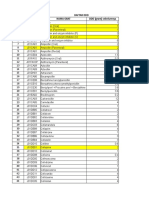0 ratings0% found this document useful (0 votes)
36 viewsCase Series .
Case Series .
Uploaded by
saraswathy sCase series are collections of patient case reports with a single exposure or outcome that are evaluated to describe clinical outcomes. They can be useful after drug approval to quantify adverse drug reactions and ensure rare reactions are not missed. However, case series lack a control group, so it is difficult to determine which features are uniquely associated with an exposure or outcome. Overall, case series provide clinical descriptions but not strong evidence of causation.
Copyright:
© All Rights Reserved
Available Formats
Download as PPTX, PDF, TXT or read online from Scribd
Case Series .
Case Series .
Uploaded by
saraswathy s0 ratings0% found this document useful (0 votes)
36 views10 pagesCase series are collections of patient case reports with a single exposure or outcome that are evaluated to describe clinical outcomes. They can be useful after drug approval to quantify adverse drug reactions and ensure rare reactions are not missed. However, case series lack a control group, so it is difficult to determine which features are uniquely associated with an exposure or outcome. Overall, case series provide clinical descriptions but not strong evidence of causation.
Original Title
case series .
Copyright
© © All Rights Reserved
Available Formats
PPTX, PDF, TXT or read online from Scribd
Share this document
Did you find this document useful?
Is this content inappropriate?
Case series are collections of patient case reports with a single exposure or outcome that are evaluated to describe clinical outcomes. They can be useful after drug approval to quantify adverse drug reactions and ensure rare reactions are not missed. However, case series lack a control group, so it is difficult to determine which features are uniquely associated with an exposure or outcome. Overall, case series provide clinical descriptions but not strong evidence of causation.
Copyright:
© All Rights Reserved
Available Formats
Download as PPTX, PDF, TXT or read online from Scribd
Download as pptx, pdf, or txt
0 ratings0% found this document useful (0 votes)
36 views10 pagesCase Series .
Case Series .
Uploaded by
saraswathy sCase series are collections of patient case reports with a single exposure or outcome that are evaluated to describe clinical outcomes. They can be useful after drug approval to quantify adverse drug reactions and ensure rare reactions are not missed. However, case series lack a control group, so it is difficult to determine which features are uniquely associated with an exposure or outcome. Overall, case series provide clinical descriptions but not strong evidence of causation.
Copyright:
© All Rights Reserved
Available Formats
Download as PPTX, PDF, TXT or read online from Scribd
Download as pptx, pdf, or txt
You are on page 1of 10
Case series
• It is a group or cluster of case reports that may be
generated by a single clinician, group of clinicians, a
hospital, pharmaceutical company, or most importantly a
regulatory agency.
• Case series are collections of patients, all of whom have
a single exposure, whose clinical outcomes are then
evaluated and described.
• Case series can be collections of patients with a single
outcome, looking at their antecedent exposures
• E g : case series on thalidomide induced
phocomelia and fatal alcohol syndrome
• Occasionally, case series may produce a false alarm
when the relationship is strictly spurious.
• For e.g. antiemetic doxylamine /pyridoxine, where
original case series suggested it was a teratogen,
but this was not confirmed by analysis of all
available data.
Advantages
• After drug marketing, case series are most useful for
two related purposes.
Firstly they can be useful for quantifying the incidence
of an ADR . The so-called “Phase IV” post marketing
surveillance study of prazosin was conducted, to
quantitate the incidence of first-dose syncope from
prazosin.
• Secondly, they can be useful for being certain that any particular
adverse effect of concern does not occur when observed in a
population which is larger than that studied prior to drug
marketing.
The “Phase IV” postmarketing surveillance study was
conducted for cimetidine. Metiamide was an H-2 blocker, which
was withdrawn after marketing outside the US because it caused
agranulocytosis . Since cimetidine is chemically related to
metiamide there was a concern that cimetidine might also cause
Limitation
• In the absence of a control group, one cannot be certain which
features in the description of the patients are unique to the
exposure, or outcome.
• As an example, one might have a case series from a particular
hospital of 100 individuals with a certain disease, and note that all
were men over the age of 60. This might lead one to conclude that
this disease seems to be associated with being a man over the age
of 60.
Conclusion
• Case series is a pharmacoepidemiology study design.
• It analyse the data from various case reports in series.
• Case series are use full after marketing of drug to quantifying
the incidence of an adverse reaction and to develop certainty
between adverse reaction and exposure of the drug.
• Case series are not very useful in determining causation, but
provide clinical descriptions of a disease or of patients who
receive an exposure.
PARTS
1. TITLE
2. KEYWORDS
3. ABSTRACT
4. INTRODUCTION
5. INDIVIDUAL CASE PRESENTATION
6. DISCUSSION
7. CONCLUSION
8. REFERENCE
You might also like
- The Subtle Art of Not Giving a F*ck: A Counterintuitive Approach to Living a Good LifeFrom EverandThe Subtle Art of Not Giving a F*ck: A Counterintuitive Approach to Living a Good LifeRating: 4 out of 5 stars4/5 (6020)
- The Gifts of Imperfection: Let Go of Who You Think You're Supposed to Be and Embrace Who You AreFrom EverandThe Gifts of Imperfection: Let Go of Who You Think You're Supposed to Be and Embrace Who You AreRating: 4 out of 5 stars4/5 (1131)
- Never Split the Difference: Negotiating As If Your Life Depended On ItFrom EverandNever Split the Difference: Negotiating As If Your Life Depended On ItRating: 4.5 out of 5 stars4.5/5 (909)
- Grit: The Power of Passion and PerseveranceFrom EverandGrit: The Power of Passion and PerseveranceRating: 4 out of 5 stars4/5 (628)
- Hidden Figures: The American Dream and the Untold Story of the Black Women Mathematicians Who Helped Win the Space RaceFrom EverandHidden Figures: The American Dream and the Untold Story of the Black Women Mathematicians Who Helped Win the Space RaceRating: 4 out of 5 stars4/5 (937)
- Shoe Dog: A Memoir by the Creator of NikeFrom EverandShoe Dog: A Memoir by the Creator of NikeRating: 4.5 out of 5 stars4.5/5 (546)
- The Hard Thing About Hard Things: Building a Business When There Are No Easy AnswersFrom EverandThe Hard Thing About Hard Things: Building a Business When There Are No Easy AnswersRating: 4.5 out of 5 stars4.5/5 (358)
- Her Body and Other Parties: StoriesFrom EverandHer Body and Other Parties: StoriesRating: 4 out of 5 stars4/5 (831)
- Elon Musk: Tesla, SpaceX, and the Quest for a Fantastic FutureFrom EverandElon Musk: Tesla, SpaceX, and the Quest for a Fantastic FutureRating: 4.5 out of 5 stars4.5/5 (479)
- The Emperor of All Maladies: A Biography of CancerFrom EverandThe Emperor of All Maladies: A Biography of CancerRating: 4.5 out of 5 stars4.5/5 (275)
- The Little Book of Hygge: Danish Secrets to Happy LivingFrom EverandThe Little Book of Hygge: Danish Secrets to Happy LivingRating: 3.5 out of 5 stars3.5/5 (434)
- The World Is Flat 3.0: A Brief History of the Twenty-first CenturyFrom EverandThe World Is Flat 3.0: A Brief History of the Twenty-first CenturyRating: 3.5 out of 5 stars3.5/5 (2281)
- The Yellow House: A Memoir (2019 National Book Award Winner)From EverandThe Yellow House: A Memoir (2019 National Book Award Winner)Rating: 4 out of 5 stars4/5 (99)
- The Sympathizer: A Novel (Pulitzer Prize for Fiction)From EverandThe Sympathizer: A Novel (Pulitzer Prize for Fiction)Rating: 4.5 out of 5 stars4.5/5 (125)
- Devil in the Grove: Thurgood Marshall, the Groveland Boys, and the Dawn of a New AmericaFrom EverandDevil in the Grove: Thurgood Marshall, the Groveland Boys, and the Dawn of a New AmericaRating: 4.5 out of 5 stars4.5/5 (273)
- A Heartbreaking Work Of Staggering Genius: A Memoir Based on a True StoryFrom EverandA Heartbreaking Work Of Staggering Genius: A Memoir Based on a True StoryRating: 3.5 out of 5 stars3.5/5 (233)
- Team of Rivals: The Political Genius of Abraham LincolnFrom EverandTeam of Rivals: The Political Genius of Abraham LincolnRating: 4.5 out of 5 stars4.5/5 (235)
- On Fire: The (Burning) Case for a Green New DealFrom EverandOn Fire: The (Burning) Case for a Green New DealRating: 4 out of 5 stars4/5 (75)
- The Unwinding: An Inner History of the New AmericaFrom EverandThe Unwinding: An Inner History of the New AmericaRating: 4 out of 5 stars4/5 (45)
- USFDA Approved Plant ListDocument4 pagesUSFDA Approved Plant Listmulkideepak100% (3)
- Module 23Document2 pagesModule 23Tricia Mae GutibNo ratings yet
- Module 1 (Lesson 1)Document11 pagesModule 1 (Lesson 1)Jovencio Jr. Milo MilanNo ratings yet
- TrastuzumabDocument14 pagesTrastuzumabAnaMateiesNo ratings yet
- Drug and Pharmacy Law No.12 of 2013 and AmendmentsDocument37 pagesDrug and Pharmacy Law No.12 of 2013 and Amendmentsmarco giuNo ratings yet
- The Opioid Epidemic:: Douglas Hill, DO, FACEP, FACOEP-DDocument16 pagesThe Opioid Epidemic:: Douglas Hill, DO, FACEP, FACOEP-DryanNo ratings yet
- E. Rodriguez Vocational High School: Department of Education Nagtahan, Sampaloc, ManilaDocument7 pagesE. Rodriguez Vocational High School: Department of Education Nagtahan, Sampaloc, ManilaJonar AbañoNo ratings yet
- Guidelines For Dispensing of Medicines (Australia)Document9 pagesGuidelines For Dispensing of Medicines (Australia)MattNo ratings yet
- Lplpo 2022Document111 pagesLplpo 2022iwul kiwul KriwulNo ratings yet
- 2 Algoritma HT JNC 8Document3 pages2 Algoritma HT JNC 8Nais Maghfiroh100% (1)
- List of Registered Drugs As of May 2012: Reg No Generic Name Brand Name Strength Form CompanyDocument15 pagesList of Registered Drugs As of May 2012: Reg No Generic Name Brand Name Strength Form CompanybgtbingoNo ratings yet
- Drugs Used To Treat AnemiaDocument36 pagesDrugs Used To Treat AnemiaMoxie Macado100% (1)
- Drug StudyDocument7 pagesDrug StudyJohn Paulo MataNo ratings yet
- Sun Pharma & Ranbaxy MergerDocument1 pageSun Pharma & Ranbaxy MergerbobNo ratings yet
- Sinaloa ChartDocument1 pageSinaloa ChartJoel CanoNo ratings yet
- Pharmacokinetics PrinciplesDocument10 pagesPharmacokinetics Principlesahsan naeemNo ratings yet
- PainDocument90 pagesPainmikErlh100% (4)
- Methods of Injection Delivery: MDSC 3203 Department of Child & Adolescent HealthDocument16 pagesMethods of Injection Delivery: MDSC 3203 Department of Child & Adolescent HealthMeko All Real EdwardsNo ratings yet
- Chapter 1 CognosyDocument27 pagesChapter 1 CognosyAsuNo ratings yet
- Renal Transplant ProtocolsDocument42 pagesRenal Transplant ProtocolsParis VlachosNo ratings yet
- HOSPITALFORMULARYDocument32 pagesHOSPITALFORMULARYRana EhtishamNo ratings yet
- Summary of Product Characteristics: PosologyDocument9 pagesSummary of Product Characteristics: Posologyddandan_2No ratings yet
- Daftar Atc DDD Antibiotik Who 2018Document12 pagesDaftar Atc DDD Antibiotik Who 2018APOTEKER RSUMMNo ratings yet
- Sympathomimetic - AdrenergicDocument3 pagesSympathomimetic - AdrenergicRohit GodaseNo ratings yet
- "Pharmaceutical Care": (Asuhan Kefarmasian)Document37 pages"Pharmaceutical Care": (Asuhan Kefarmasian)Ririn sefrianiNo ratings yet
- Nsaids and DmardsDocument59 pagesNsaids and DmardsBaidawu Weso-amo IbrahimNo ratings yet
- 2017 (Laporan Pelayanan Rawat Jalan Dr. Ida Ayu Anom Margareni)Document11 pages2017 (Laporan Pelayanan Rawat Jalan Dr. Ida Ayu Anom Margareni)Anggi RiyaniNo ratings yet
- FP Spec.Document3 pagesFP Spec.ShagorShagorNo ratings yet
- Pharmacology and Clinical Pharmacology HandbookDocument24 pagesPharmacology and Clinical Pharmacology HandbookGurpreet SinghNo ratings yet
- Ramipril Drug StudyDocument3 pagesRamipril Drug StudyCheezy Bread0% (1)






































































